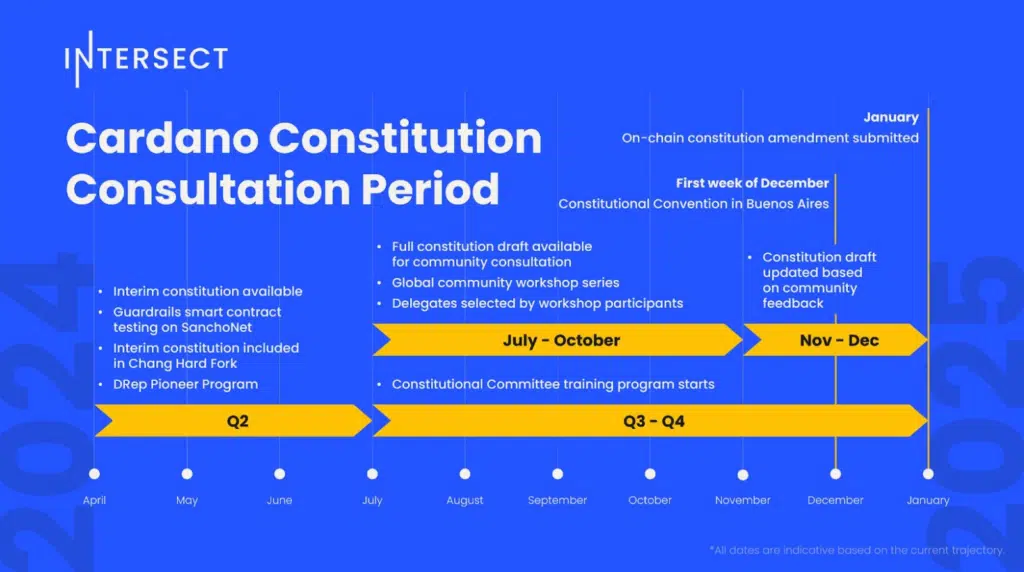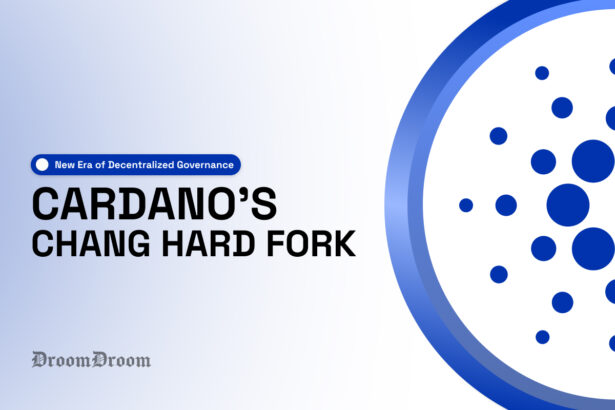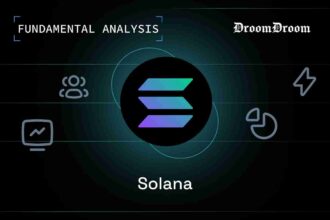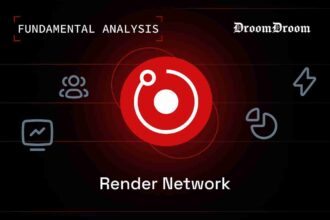The Cardano blockchain has undergone a huge upgrade with the Chang Hard Fork. It was implemented on September 1, 2024, at 21:45 UTC. With this we can assume the blockchain’s entrance into the Voltaire era which is characterized by decentralized governance (aka community-led decision-making).
- What Exactly Is the Chang Hard Fork?
- The Voltaire Era: Cardano’s Move Toward Decentralization
- Key Features of the Chang Hard Fork
- Decentralized Governance
- Delegate Representatives (DReps)
- Interim Cardano Constitution
- Plutus V3
- Improvement in Scalability and Security
- What Are Specific Changes Validators Need to Make for the Chang Hard Fork?
- The Two Phases of the Chang Hard Fork
- Comparison of Chang Hard Fork with Other Major Hard Forks
- Challenges and Potential Risks
- Conclusion
No this hard fork is not merely a technical update! It shows us a transformation of how the Cardano ecosystem is governed. Through decentralized governance, Cardano puts power in the hands of ADA holders to ensure that decisions about the network are made by the community and not centralized entities!
What Exactly Is the Chang Hard Fork?
The Chang Hard Fork is a very talked-about upgrade to transition Cardano into a decentralized governance model. This means that the community of ADA holders will play a significant role in decision-making processes about the network’s future.
But it’s not just about governance! It also introduces a technical framework that improves scalability, security and smart contract capabilities. That basically is supposed to increase the network’s transaction throughput from 250 TPS to over 1,000 TPS.
Charles Hoskinson who is the founder of Input Output Global (IOG) gave his two cents on this saying, “This dwarfs Bitcoin. It’s unique, and books will be written about what has happened… Cardano is now a governance virus that is living, self-replicating and self-sustaining. It has intelligence and a will to survive and grow. Nothing can shut it down. Nothing can stop its growth.”
At its core, the Chang Hard Fork is a community-driven effort. The Cardano network is moving away from being governed by centralized entities like IOG, Emurgo and the Cardano Foundation to entirely handing control over to ADA holders.
You might wonder what is the Voltaire era, though?
The Voltaire Era: Cardano’s Move Toward Decentralization
Since its inception in 2017, Cardano’s roadmap has been divided into distinct eras. Each era focuses on bringing about improvements in specific functionalities of the blockchain.
- Byron: Established the blockchain’s foundation
- Shelley: Introduced decentralization
- Goguen: Enabled smart contracts
- Basho: Optimized scalability

If you want to fully understand the importance of Cardano’s Chang Hard Fork then of course it’s essential to grasp the context of its evolution.
Prior to the Voltaire era, the Basho era concentrated on scalability and optimization with some significant improvements brought by the Vasil Hard Fork. However, the Voltaire era goes beyond technical upgrades. It addresses one of the most critical aspects of blockchain technology — governance.
Key Features of the Chang Hard Fork
We shall now discuss the Chang Hard Fork’s innovative features—
Decentralized Governance
We have touched upon this already earlier. Cardano’s new governance model enables ADA holders to participate in decisions about protocol changes, treasury management and other network-related matters. Through on-chain voting, they can submit proposals and cast votes directly on the blockchain.
Delegate Representatives (DReps)
Not all ADA holders may have the time or expertise to vote on every proposal. Well to address this exact thing DReps will be elected to represent ADA holders to ensure efficient decision-making.
Interim Cardano Constitution
The hard fork also introduces an Interim Constitution which acts as a guiding document for governance decisions during the transition. This constitution will be interpreted by the Interim Constitutional Committee (ICC). It is a temporary governance body responsible for upholding the principles of this new system.
Plutus V3
Cardano’s smart contract language–Plutus–receives a significant upgrade with version V3. Yes that’s right! It introduces improved cryptographic features and performance enhancements for developers to build and deploy decentralized applications (DApps).
Improvement in Scalability and Security
With an amazingly ambitious goal of increasing transaction throughput to over 1,000 TPS the Chang Hard Fork implements optimizations that significantly improve Cardano’s performance. Also let me tell you that the introduction of advanced security protocols strengthens the network against external threats. It’s cool right?
What Are Specific Changes Validators Need to Make for the Chang Hard Fork?
Validators or Stake Pool Operators (SPOs) are the role models who ensure the smooth operation of the Cardano network. With the Chang Hard Fork validators have to make several important updates and here they are —
1. Node Upgrade
At least 70% of validators are required to upgrade their nodes to version 9.1.0 or later to make sure that there is compatibility with the new governance features.
2. Participation in Governance
Validators will also have a key role in voting on governance proposals using their delegated ADA. They will need to engage actively in this governance model to represent the ADA holders who delegate voting power to them.
3. Support for New Protocols
Validators must make sure that their infrastructure is ready for changes in transaction processing and the smart contract functionalities introduced by Plutus V3 enhancements.
The Two Phases of the Chang Hard Fork
The Chang Hard Fork is being rolled out in two distinct phases for a smooth transition into decentralized governance, let’s go over them shall we?
Phase 1
Implemented on September 1, 2024, this phase laid the foundation for decentralized governance. It introduced basic governance structures including the Interim Constitutional Committee and the voting framework for ADA holders and DReps.
The focus of this phase was to prepare the ecosystem particularly Stake Pool Operators (SPOs) and DApps for the upcoming changes.
Phase 2
Expected in Q4 2024 this phase will activate advanced governance features such as on-chain voting. Also it is great to know that it will further empower DReps to represent community interests effectively. By the end of this phase, the Cardano community will have full control over governance processes. You know it will be a historic moment in the blockchain’s evolution.

Comparison of Chang Hard Fork with Other Major Hard Forks
Many blockchain projects have sought to distribute control across their communities but we can observe that Cardano’s approach is distinct.
| Feature | Chang Hard Fork (Cardano) | Ethereum’s London Hard Fork | Bitcoin Cash Hard Fork |
| Type | Major upgrades with community governance | Major upgrade with EIP 1559 | Split into Bitcoin Cash (BCH) |
| Governance | Decentralized through ADA holders | Centralized development team | Split governance post-fork |
| Key Innovations | On chain governance and DReps | Fee market change and EIP 1559 | Increased block size |
| Community Impact | Direct influence on protocol | Indirect influence via proposals | Creation of 2 separate chains |
Challenges and Potential Risks
As we say it, you have to take the rough with the smooth. Similarly, while the Chang Hard Fork is a really big leap forward for Cardano, the transition to decentralized governance is not without risks.
There is always the possibility of community disengagement you know. If ADA holders do not actively participate in governance processes, centralized dynamics could re-emerge. Also, there are technical challenges associated with the implementation of new governance protocols.
Not to mention we have to consider the risks of market volatility during significant network upgrades. Historical trends show that hard forks can lead to fluctuations in token prices due to speculation or uncertainty. So I’d say that this is a point that you as investors and ADA holders must watch closely.
Conclusion
The Chang Hard Fork is more than a technical upgrade, no. It is a ‘moment’ in Cardano’s journey toward full decentralization. By enabling on-chain governance, empowering ADA holders and improving the blockchain’s technical infrastructure this hard fork is definitely a new chapter in the evolution of the Cardano ecosystem.
With the Voltaire era now underway, Cardano will lead amazingly the charge in decentralized governance and set a precedent for other blockchain networks to follow.
In the words of Giorgio Zinetti, CTO of the Cardano Foundation,”I would say it is the biggest event in Cardano history and it really makes us different from many other chains. I think we are the largest layer 1 with on-chain governance”.




















